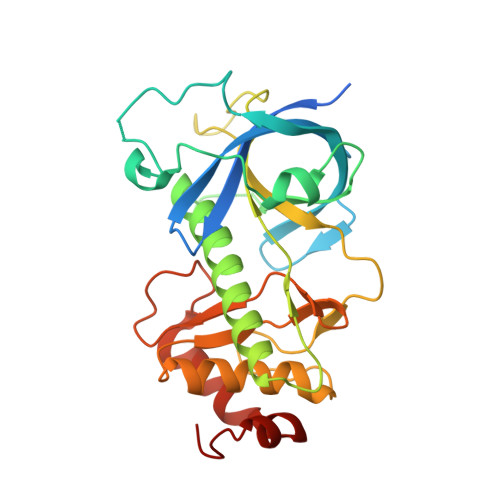Autophosphorylation Activates Dictyostelium Myosin II Heavy Chain Kinase A by Providing a Ligand for an Allosteric Binding Site in the {alpha}-Kinase Domain.
Crawley, S.W., Gharaei, M.S., Ye, Q., Yang, Y., Raveh, B., London, N., Schueler-Furman, O., Jia, Z., Cote, G.P.(2011) J Biol Chem 286: 2607-2616
- PubMed: 21071445
- DOI: https://doi.org/10.1074/jbc.M110.177014
- Primary Citation of Related Structures:
3PDT - PubMed Abstract:
Dictyostelium discoideum myosin II heavy chain kinase A (MHCK A), a member of the atypical α-kinase family, phosphorylates sites in the myosin II tail that block filament assembly. Here we show that the catalytic activity of A-CAT, the α-kinase domain of MHCK A (residues 552-841), is severely inhibited by the removal of a disordered C-terminal tail sequence (C-tail; residues 806-841). The key residue in the C-tail was identified as Thr(825), which was found to be constitutively autophosphorylated. Dephosphorylation of Thr(825) using shrimp alkaline phosphatase decreased A-CAT activity. The activity of a truncated A-CAT lacking Thr(825) could be rescued by P(i), phosphothreonine, and a phosphorylated peptide, but not by threonine, glutamic acid, aspartic acid, or an unphosphorylated peptide. These results focused attention on a P(i)-binding pocket located in the C-terminal lobe of A-CAT. Mutational analysis demonstrated that the P(i)-pocket was essential for A-CAT activity. Based on these results, it is proposed that autophosphorylation of Thr(825) activates ACAT by providing a covalently tethered ligand for the P(i)-pocket. Ab initio modeling studies using the Rosetta FloppyTail and FlexPepDock protocols showed that it is feasible for the phosphorylated Thr(825) to dock intramolecularly into the P(i)-pocket. Allosteric activation is predicted to involve a conformational change in Arg(734), which bridges the bound P(i) to Asp(762) in a key active site loop. Sequence alignments indicate that a comparable regulatory mechanism is likely to be conserved in Dictyostelium MHCK B-D and metazoan eukaryotic elongation factor-2 kinases.
Organizational Affiliation:
Department of Biochemistry, Queen's University, Kingston, Ontario K7L 3N6, Canada.


















